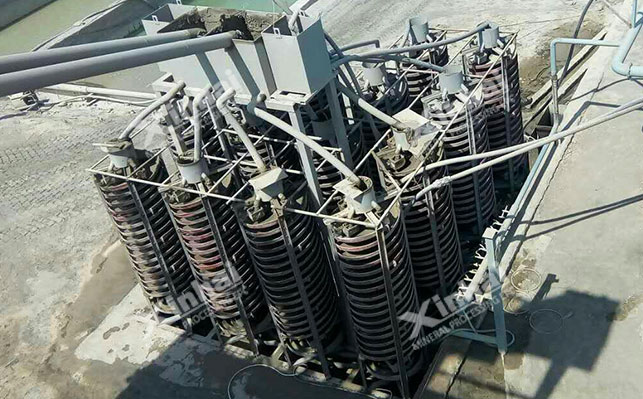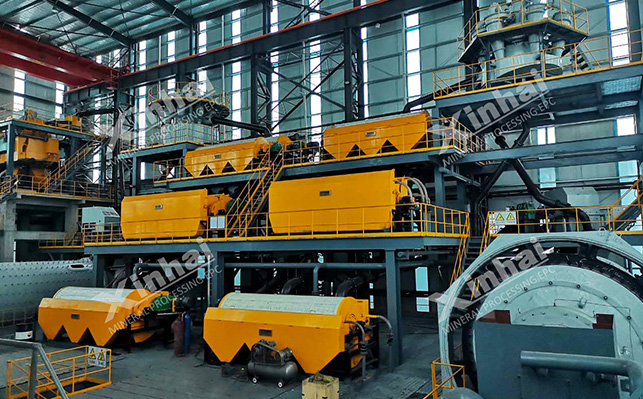Rutile is a titanium containing oxide mineral with the chemical formula TiO₂. It usually appears dark red, brown, or black, with a metallic luster and high hardness. Its crystal structure is tetragonal, and common crystal shapes include columnar and needle like. Mainly produced in metamorphic and magmatic rocks, it coexists with minerals such as ilmenite and magnetite. The following introduces the main beneficiation methods for rutile.
The reselection method utilizes the density difference between hematite and gangue minerals for sorting. Rutile has a relatively high density, usually ranging from 4.2-4.3g/cm ³, while gangue minerals have a relatively low density. The main methods include shaking tables, chutes, and heavy medium separation.

Shaking Table: Utilizing asymmetric reciprocating motion of the shaking table surface and horizontal water flow flushing, different density minerals are divided into zones on the bed surface, suitable for recovering coarse-grained hematite.
Spiral chute:Utilizing the centrifugal force and gravity of the slurry in the spiral groove, different density minerals are deposited at different positions in the spiral groove, suitable for rough and sweep selection of rutile.
Heavy medium:Separation is achieved by utilizing the characteristics of heavy media (such as ferrosilicon, magnetite, etc.) with a density greater than that of gangue minerals and less than that of hematite, resulting in high separation efficiency and large processing capacity, but high equipment investment and operating costs.
Magnetic separation method separates minerals based on the magnetic differences between rutile and gangue. Rutile is generally a weakly magnetic mineral, while gangue minerals are mostly non-magnetic minerals. Including dry magnetic separation and wet magnetic separation.
Dry magnetic separation:Carried out in a dry state, suitable for processing coarse-grained rutile ore. The equipment mainly includes permanent magnet drum magnetic separators, dry magnetic separation rollers, etc. It has a large processing capacity and low cost, but the sorting accuracy is relatively low.
Wet magnetic separation:Carried out in water or other liquid media, suitable for processing fine-grained hematite ore. The equipment includes wet permanent magnet drum magnetic separators, wet high gradient magnetic separators, etc., with high sorting accuracy and strong adaptability, but high equipment investment and operating costs.

The flotation method separates minerals based on the differences in surface physical and chemical properties between rutile and gangue minerals. Rutile has a certain degree of hydrophobicity, while gangue minerals are mostly hydrophilic minerals. There are conventional flotation, chelation flotation, and combined flotation.
Conventional flotation:Using collectors such as fatty acids and amines, the operation is simple and the cost is low, but the sorting accuracy is relatively low, and the recovery effect of fine-grained hematite is poor.
Chelated flotation:Using chelating agents as collectors, stable chelates can be formed with metal ions on the surface of rutile, making the surface hydrophobic and improving flotation recovery and grade. However, chelating agents are expensive and relatively costly.
Combined flotation:Combining multiple methods such as reselection, magnetic separation, and flotation to comprehensively separate hematite can fully leverage the advantages of each method, improve mineral processing efficiency and grade.
The electric selection method utilizes the difference in conductivity between hematite and gangue minerals for sorting. Rutile has a certain degree of conductivity, while gangue minerals are mostly non-conductive minerals. There are high-voltage electric selection and friction electric selection.
High voltage electric selection:Carried out in a high voltage electric field, suitable for processing fine-grained rutile ore. The equipment includes high-voltage electric separators, electrostatic beneficiation machines, etc., with high sorting accuracy and large processing capacity, but the equipment investment and operating costs are high.
Triboelectric sorting:Using the phenomenon of mineral frictional electrification for sorting, hematite and gangue minerals generate different charges and are subjected to different forces in an electric field to achieve sorting. The equipment is simple and cost-effective, but the sorting accuracy is relatively low.
The chemical beneficiation method uses chemical reagents to undergo chemical reactions with hematite for separation. There are mainly acid leaching method, alkali leaching method, and chlorination method.
Acid leaching method:Using acid reagents such as sulfuric acid and hydrochloric acid to leach hematite can remove impurities such as iron and aluminum, improve grade, but it will produce a large amount of acidic wastewater that needs to be treated, otherwise it will pollute the environment.
Alkali leaching method:Using alkaline reagents such as sodium hydroxide and sodium carbonate for leaching, impurities such as silicon and aluminum can be removed, and the grade can be improved. The wastewater is relatively small, but it needs to be carried out under high temperature and pressure, resulting in high equipment investment and operating costs.
Chlorination method:Using chlorine gas, hydrogen chloride and other chlorinating agents to chlorinate rutile, titanium is converted into titanium tetrachloride, and then titanium dioxide is prepared through distillation, oxidation and other processes. The process flow is short and the product quality is high, but it is carried out at high temperatures, resulting in high equipment investment and operating costs, as well as environmental pollution.
In actual production, the beneficiation method of rutile should be determined based on the properties of the ore and the scale of the beneficiation plant. It is recommended to conduct mineral processing test analysis and design suitable gold ore beneficiation methods to improve beneficiation efficiency and grade, and achieve efficient utilization of rutile resources.